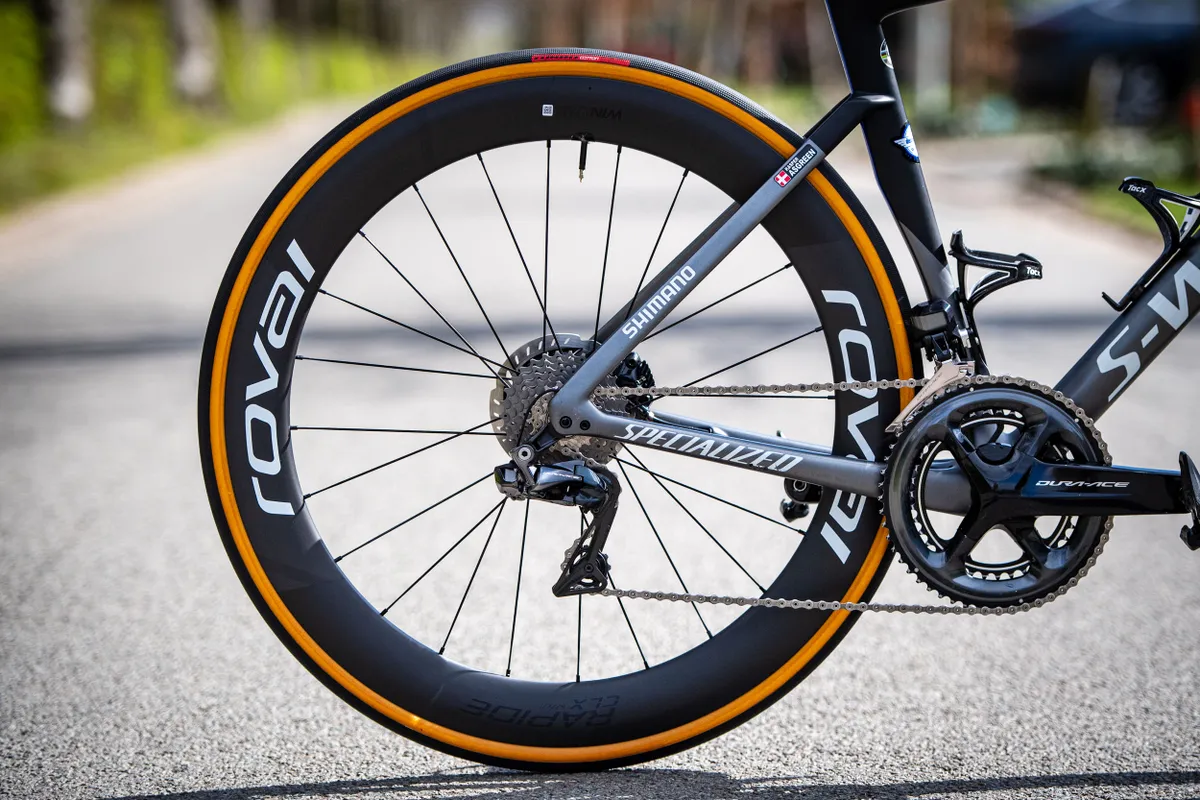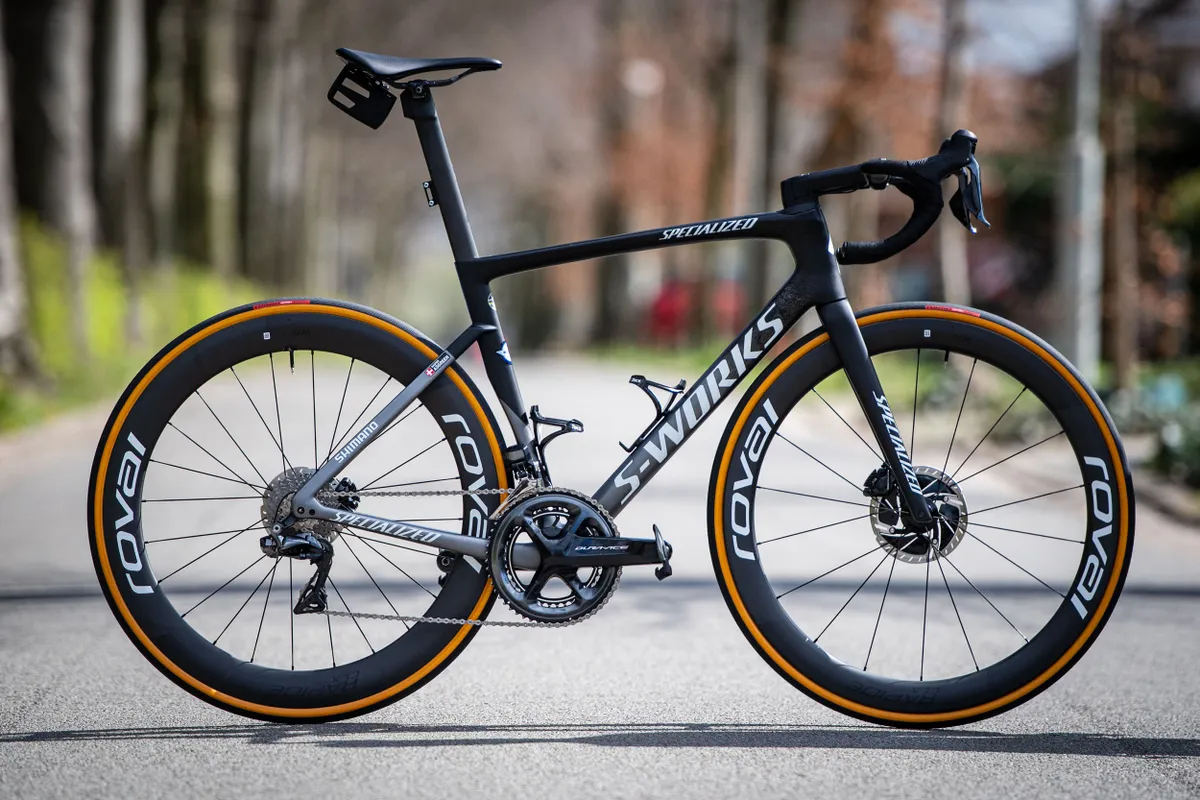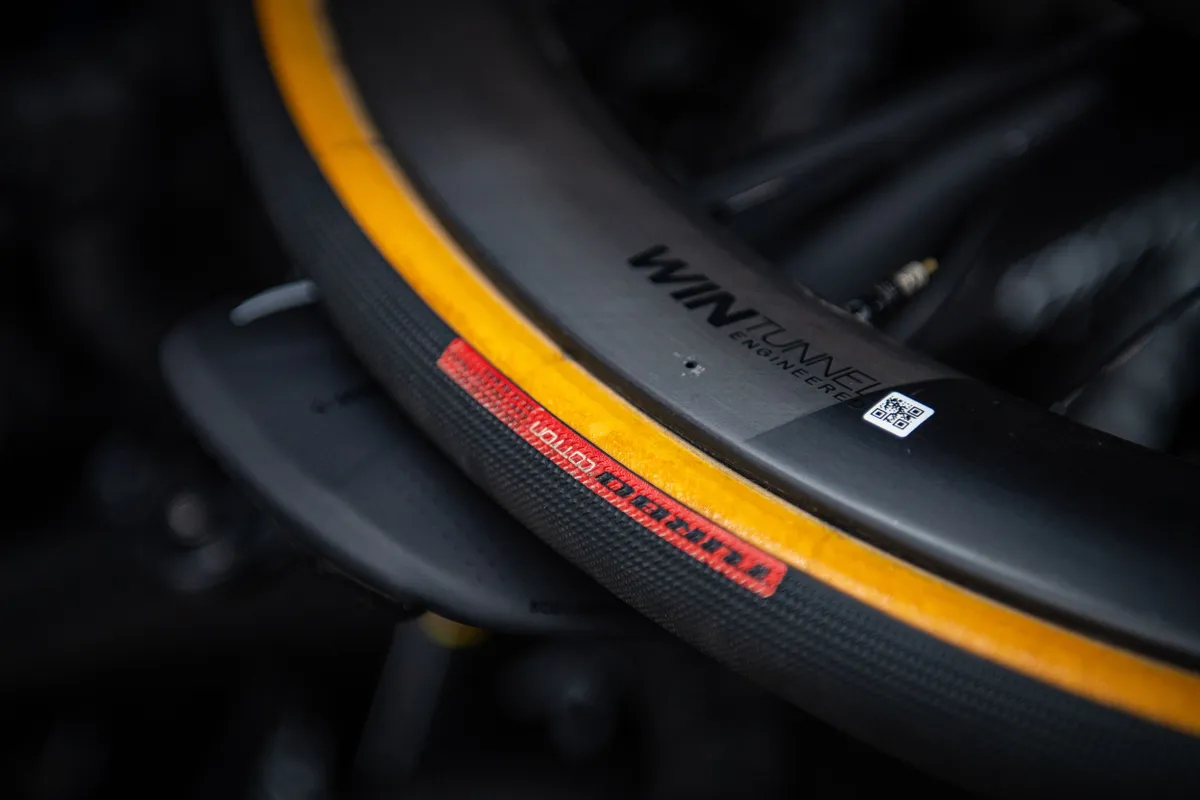For those who missed it, Kasper Asgreen of WorldTour team Deceuninck-QuickStep took victory at the 2021 Tour of Flanders last weekend.
Although the manner of his victory came as a surprise to many (Asgreen beat Mathieu van der Poel – winner of the 2020 edition and perhaps the most explosive one-day rider in the peloton – in a straight, two-up sprint), one other thing that drew a small flurry of attention was his Specialized S-Works Tarmac SL7 equipped with clincher tyres and latex inner tubes.
As far as the cycling world can tell, this appears to be the first time a rider has won on clinchers. It’s particularly intriguing because one half of the pro peloton is steadfastly refusing to abandon their beloved tubulars, while the other is seeking performance advantages/bending to sponsor pressures (delete as per your personal view) and transitioning to tubeless tyre systems.
The state of play for tyres in the WorldTour
- Tubular tyres – a one-piece tyre system where an inner tube is sewn into a cotton or nylon casing, and glued onto a tubular specific rim – have been the dominant tyre system in professional road racing, stretching back to its earliest days.
- Clincher tyres, as used by most amateur cyclists for decades, have made occasional forays into professional road racing, but there has never been widespread adoption of this tech within the professional peloton.
- Tubeless tyres (which function like clincher tyres with the inner tube removed) have started to make significant inroads into professional racing in recent years, as wheel and tyre brands champion their advantages, but teams and riders remain divided on the subject.
- Asgreen’s win comes at a time when the debate appeared to be leaning decisively towards tubeless – so does it upset the apple cart?
Being the resident road tyre nerd here at BikeRadar, I decided to take a closer look at why one team has pivoted to clinchers and what it might mean for the future of road racing tyres.
Let’s deal with the first point – why were Deceuninck-QuickStep riders using clincher tyres?
As we pointed out in a pro tech trends feature at the start of the spring classic’s campaign, and during last year’s Tour de France, it’s because Specialized – the team's bike, wheel and tyre sponsor – believes the combination of its Roval Rapide CLX carbon clincher wheels and S-Works Turbo Cotton clincher tyres to be the fastest all-round setup, when taking into account rolling resistance, weight and aerodynamic performance.
Though there’s a nominally increased risk of pinch flats compared to tubular tyres, that doesn’t appear to have been an issue at any point during this year’s classics campaign.
It’s no surprise the Specialized tyres match tubulars for ride quality and comfort either because the Turbo Cottons use a 320 threads per inch (TPI), non-vulcanised casing in an open-tubular design.
This means the tread is glued on to a supple, cotton tyre casing in a similar way to how traditional cotton tubulars are made. Asgreen was using a larger, 28mm-wide ‘Hell of the North’ variant of the tyre, but other than a slightly enlarged tread, it uses the same construction.
It’s also worth pointing out that the Roval Rapide CLX wheels, which Specialized believes are its best in terms of aerodynamics, aren’t tubeless compatible (despite having an inner rim shape that looks very much like they should be).
It’s possible that if the wheels were tubeless compatible the balance might shift in that favour. Removing the inner tube from the setup can potentially lower rolling resistance even further, depending on the exact characteristics of the tyre setups being compared. Indeed, that’s what Specialized was telling us in 2019.
To deal with the 200g elephant in the room, yes, clincher setups are usually a few hundred grams heavier than tubular setups. But, for the last time (clearly this won’t be the last time I have to say this), it doesn’t matter.
When it comes to road tyre performance, the marginal weight savings of a tubular setup simply do not outweigh the rolling resistance losses on anything but the steepest gradients (it’s a different story in track racing, but that’s another topic altogether). This has been proved countless times by many different brands and independent sources, including us. It is a fact.

This is largely because the rolling resistance losses in a tubular setup come from the glue required to attach the tyre to the rim, and the increased amount of material between the tyre casing and inner tube.
Both of these increase friction in the system and sap precious watts. Small differences in wheel weight do not affect performance to the degree it is commonly assumed. Instead, aerodynamics and rolling resistance are the largest determinants of how ‘fast’ a wheel and tyre setup is or isn’t.
It’s also fun to note that Asgreen was using 28mm tyres, which may have measured even larger when installed on his Roval wheels (given they have a 21mm internal rim width, and wider internal rim widths tend to increase inflated tyre width slightly).

Though that probably sounds like the minimum tyre width any sensible cyclist would choose for a cobbled classic, 25mm tyres were the standard for de Ronde just a few short years ago, with 28s or larger only brought out for the especially brutal secteurs of Paris-Roubaix.
This was partly due to the constraints of rim brakes and race bike design, which in days gone by didn’t give much consideration to tyre clearance. Previously, it wasn’t uncommon to see pros switch to endurance, cyclocross or even outlandish custom bikes for the cobbled classics in order to get more tyre clearance and a smoother ride.
Now that most modern, disc-brake equipped race bikes can accommodate 28mm tyres or larger, we’re seeing a growing number sticking to their standard, aero-optimised race bikes for practically everything. I expect we’ll see tyres around 30mm or wider at Paris-Roubaix (this year’s race has been postponed until 3 October 2021), so it will be interesting to see which bikes the teams use to make this possible.
Once real-world tyre pressures are accounted for, I’m not convinced wider tyres actually roll any faster than narrow ones on normal roads. But, it is undeniable that wider tyres offer greater comfort and traction on rough roads, and that’s clearly a performance advantage in races like this.
With the increasing availability of aerodynamic wheels designed specifically for wider tyres, there’s often not even an aerodynamic penalty for using larger tyres. So, if you’re ever taking on a cobbled sportive, use the largest tyres your bike can accommodate – you won’t regret it (trust us, we’ve tried it).
Whoop-de-doo, what does it all mean?
Where does this leave the state of tyre choice for the professional peloton (and speed-obsessed mortals like myself), though?
My money’s still on tubeless taking over completely, in the long term. Tubeless tyres can be just as fast as clinchers in terms of rolling resistance, but they also have the ability for the sealant to fix small punctures as you ride. It’s a winning formula.
The current issue – as some of our readers may have personally experienced – is that road tubeless standards are a bit of a mess right now. It’s difficult to be sure whether any two sets of tubeless-ready tyres and wheels from separate manufacturers will play nicely together or not.
Clincher setups, on the other hand, are easy to use, reliable and – as proven by Asgreen, Specialized and countless others – potentially very fast.
Nevertheless, I do think the issues with tubeless are easing as the adoption of the latest ETRTO standards becomes more widespread throughout the industry.

If I was to speculate, I also think that tyre liners for road tubeless tyres might be the run-flat solution that finally puts the last nail in the coffin for tubular tyres in the pro peloton.
Up until this point, the ability to keep riding for a while on a punctured tubular tyre was arguably the last major performance and safety advantage tubular systems had over clincher and tubeless tyres.
Given a tubeless setup run in conjunction with a tyre liner can mimic that characteristic, it’s hard to see what meaningful advantages are left for tubulars.
What do you think? Does Asgreen’s Tour of Flanders win mean we’re about to see a clincher tyre renaissance? Are tubulars on life support or is there life in the old tyre yet? Let us know in the comments below…



